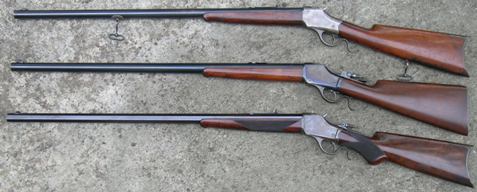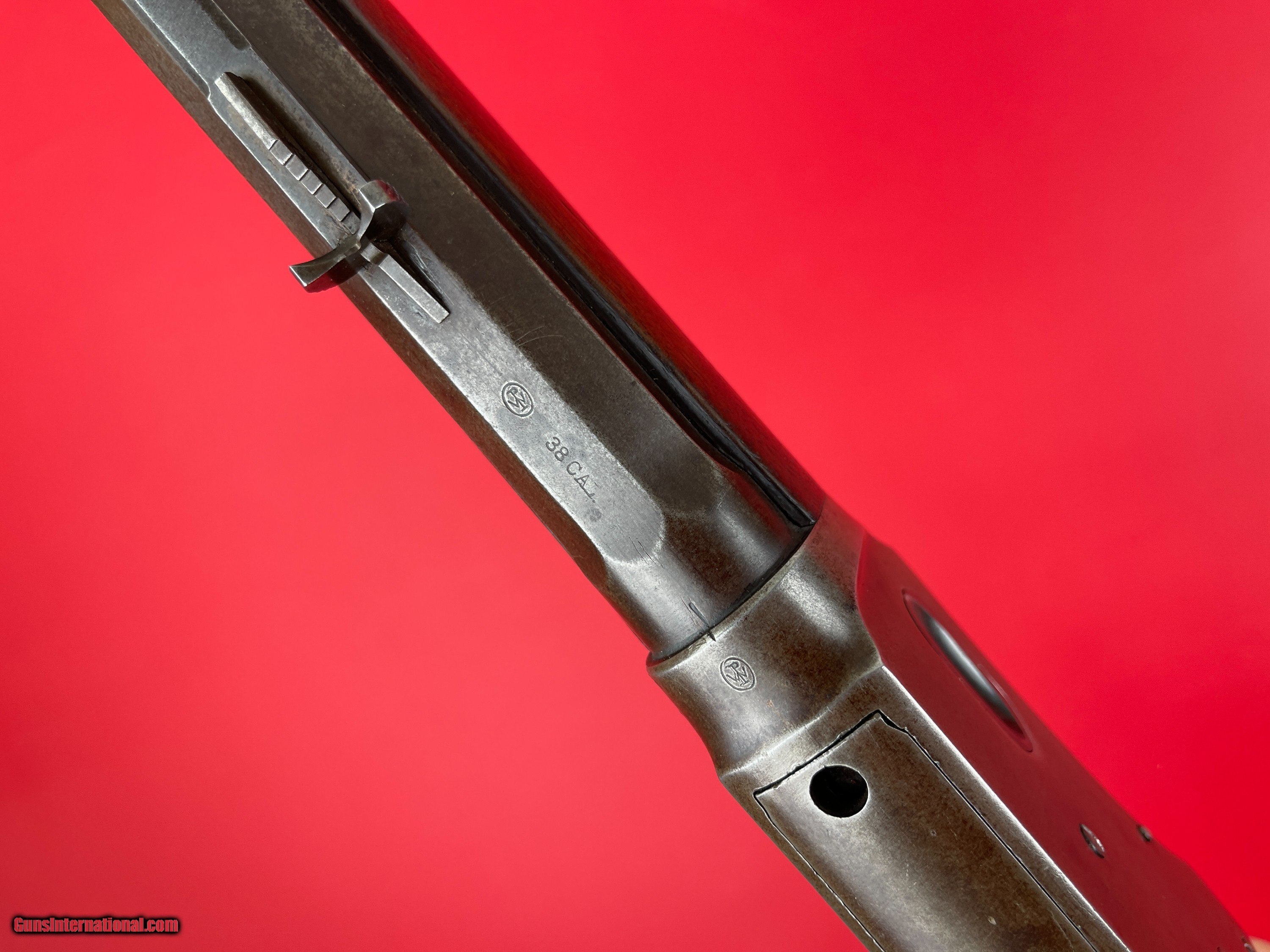November 7, 2015
 Offline
OfflineDoes look a little out of place. Most likely an interesting story about how it got there.
Mike
May 23, 2009
 Offline
OfflineOn February 8th, 1888 Winchester purchased the Whitney Arms Company and sold of the remaining stock of Whitney rifles. It stands to reason that possibly they still had some on hand until after 1905 and sold them. That at that time they were proof marked after proof firing them before leaving the factory.
Or even more likely possibly someone having known that Whitney was bought out by Winchester. Sent the rifle back to Winchester for repair and Winchester repaired it with parts still on hand or made the parts, and then proofed the rifle before returning to the customer.
All the Whitney rifles were chambered for the same calibers as the Model 73 & 76 Winchester.
I’ve never seen any but supposedly some of the late production Whitney rifles were assembled and sent out with Winchester marked barrels. I have no idea what those markings consist of but assume the standard Winchester barrel address.
Sincerely,
Maverick
![]()
WACA #8783 - Checkout my Reloading Tool Survey!
https://winchestercollector.org/forum/winchester-research-surveys/winchester-reloading-tool-survey/
November 19, 2006
 Offline
OfflineMaverick said
On February 8th, 1888 Winchester purchased the Whitney Arms Company and sold of the remaining stock of Whitney rifles. It stands to reason that possibly they still had some on hand until after 1905 and sold them. That at that time they were proof marked after proof firing them before leaving the factory.Or even more likely possibly someone having known that Whitney was bought out by Winchester. Sent the rifle back to Winchester for repair and Winchester repaired it with parts still on hand or made the parts, and then proofed the rifle before returning to the customer.
All the Whitney rifles were chambered for the same calibers as the Model 73 & 76 Winchester.
I’ve never seen any but supposedly some of the late production Whitney rifles were assembled and sent out with Winchester marked barrels. I have no idea what those markings consist of but assume the standard Winchester barrel address.
Sincerely,
Maverick
Interesting information and theories. This particular rifle dates to 1882, so should have been long gone from the factory by the time Winchester took over. So, perhaps it’s an example of having been sent to Winchester for repair in 1888 or after. Intriguing.
April 15, 2005
 Offline
Offlinesteve004 said
Maverick said
On February 8th, 1888 Winchester purchased the Whitney Arms Company and sold of the remaining stock of Whitney rifles. It stands to reason that possibly they still had some on hand until after 1905 and sold them. That at that time they were proof marked after proof firing them before leaving the factory.
Or even more likely possibly someone having known that Whitney was bought out by Winchester. Sent the rifle back to Winchester for repair and Winchester repaired it with parts still on hand or made the parts, and then proofed the rifle before returning to the customer.
All the Whitney rifles were chambered for the same calibers as the Model 73 & 76 Winchester.
I’ve never seen any but supposedly some of the late production Whitney rifles were assembled and sent out with Winchester marked barrels. I have no idea what those markings consist of but assume the standard Winchester barrel address.
Sincerely,
Maverick
Interesting information and theories. This particular rifle dates to 1882, so should have been long gone from the factory by the time Winchester took over. So, perhaps it’s an example of having been sent to Winchester for repair in 1888 or after. Intriguing.
It would have been sent to Winchester after July 1905 to have those proof marks on it. Personally, I have serious doubts that Winchester would have “R & R’d” and proofed that rifle.
Bert
WACA Historian & Board of Director Member #6571L

November 19, 2006
 Offline
OfflineJeremy P said
Pretty fair price for that I think. Interesting stamps and valid theories….
The .38-40 is fairly rare in the Whitney-Kennedy with the .44-40 being vastly more common.
The upper tang has been broken and welded up. I’m doubting Winchester did this. But I’ve been wrong before.
March 20, 2010
 Offline
OfflineIm not familiar with Whitney Kennedy’s and for what its worth, I can see no added value to the rifle. The caliber markings and the indexing mark appear the same as on others, and the barrel appears to be a WK barrel. The WP proof mark does not look unlike other proofs as found on other Win models circa the early 1900’s. It also looks like they’ve been there on the barrel/receiver for an extremely long time, not contrast from the existing condition. Without throwing the baby out with the bath water, Id chalk up the “why” to just another unanswered Winchester question or anomaly and move on down the road.
Thanks for the break from work Steve.
1892takedown @sbcglobal.net ......NRA Endowment Life Member.....WACA Member
"God is great.....beer is good.....and people are crazy"... Billy Currington
November 7, 2015
 Offline
OfflineGood eye, Steve. Most folks would not have taken notice of this little anomaly. Will be interesting to see if any more WK’s turn up with these proof marks.
Mike
November 19, 2006
 Offline
OfflineTXGunNut said
Good eye, Steve. Most folks would not have taken notice of this little anomaly. Will be interesting to see if any more WK’s turn up with these proof marks.
Mike
Mike –
I talked to a fellow Whitney-Kennedy/Burgess collector yesterday and brought up this topic. He’s collected these rifles for 50 some years. Somewhere around 15 years ago he, myself and a couple other long-time Whitney-Kennedy collectors (including Dale Olson who wrote the book on the 1878 Burgess Long Range Rifle) put on a large display at the NRA Trophy Show in Dallas, Texas. Maybe you were there and saw the display? Unfortunately, there’s only two of us from that group that remain alive – and a tremendous amount of knowledge has been lost. I don’t recall anyone from that group had a Whitney-Kennedy rifle with Winchester proofs on it. When I asked Warren yesterday, he said it seemed that years ago he had maybe heard of a W-K rifle with Winchester marks but had never seen actually seen an example. So… it’s hard for me to imagine this example is part of a greater theme.
Here’s a picture from that display. That’s Lew Steadman to the right. He also was a very long-term Whitney-Kennedy/Burgess collector and had a large collection. After he passed, it took Amoskeag four separate auctions to sell it all. He had prototypes, engraved rifles, rare variations, high condition rifles, etc. etc.
November 7, 2015
 Offline
OfflineGood eye, Steve. Most folks would not have taken notice of this little anomaly. Will be interesting to see if any more WK’s turn up with these proof marks.
Mike
1 Guest(s)


 Log In
Log In







